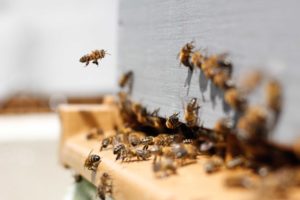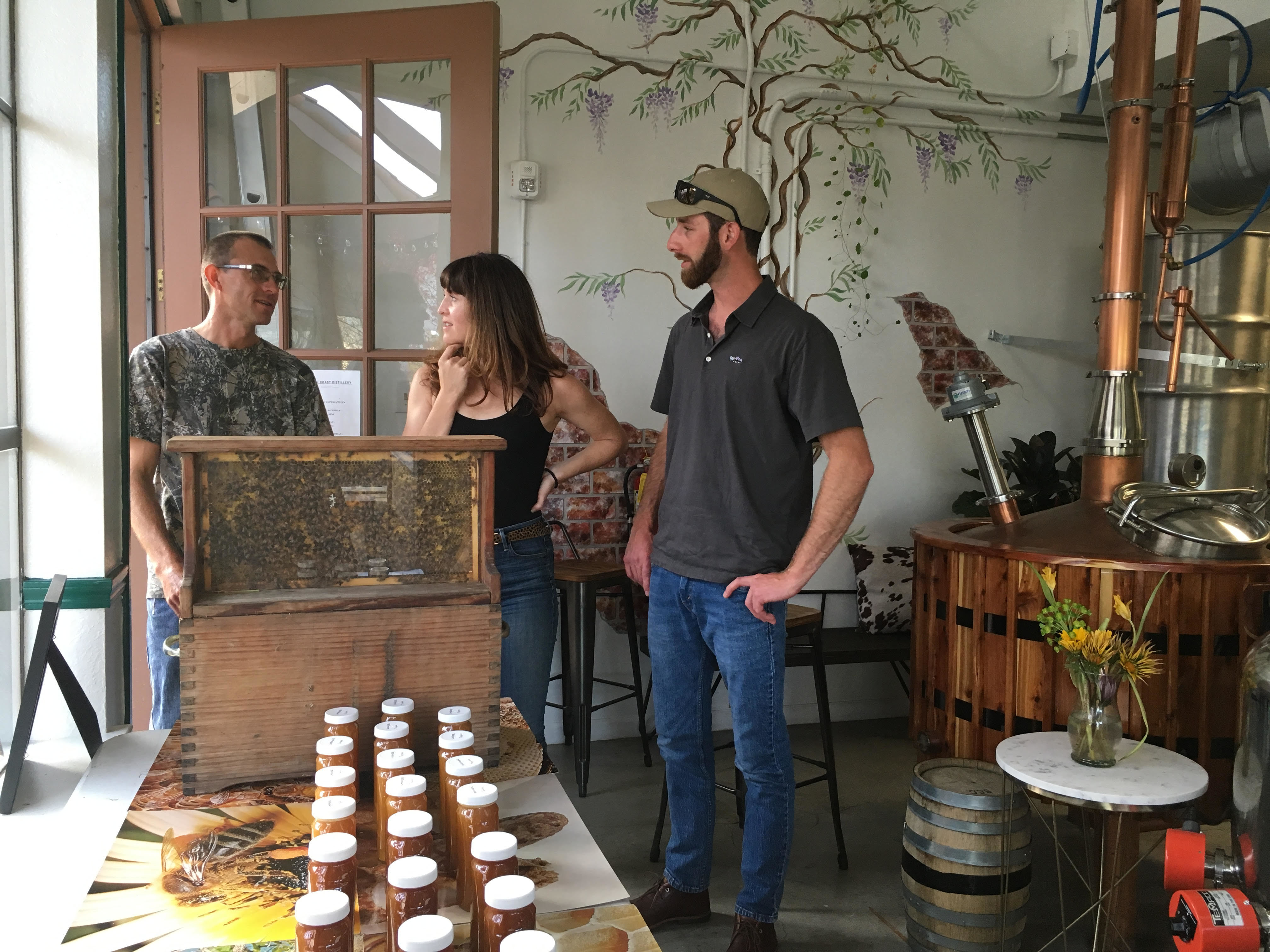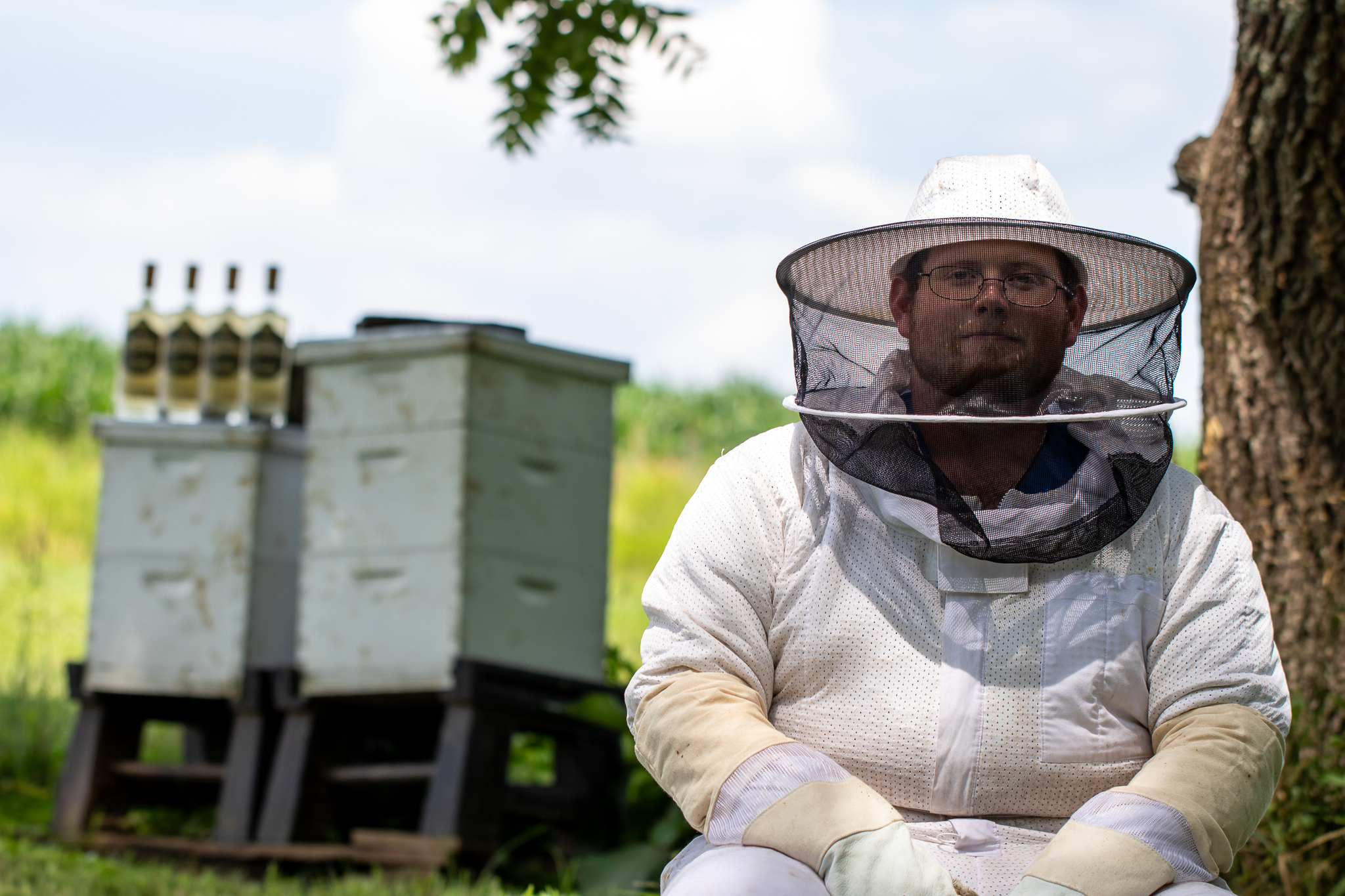
Many distillers and brewers not only make deliciously-tasting alcoholic beverages infused with honey, but they also go a step further in their love for honey’s creators — the honey bee. From the bee to the bottle, the honey-making process is a sight to behold, and in our industry, there are professionals who are sharing their love for the honey bee in a multitude of ways, one being having hives housed onsite their brewery or distillery. We talked to several of these distillers and brewers and found that each has their own personal take as to why they decided to put hives at their facility. Each hive also has a story, from a roof hive only accessible by crane to an educational hive accessible to bees through a wall.
We spoke with five such individuals who have opted to have hives on-site, resulting in some unique ways to view these amazing creatures up close and personal. Here are their stories, along with the made-with-honey spirits most popular at each location:
Honey House Distillery, Durango, Colorado
As told by Maia Huey, the distillery’s marketing consultant and event coordinator
“Honey House Distillery was started by the owners of Honeyville, a third-generation beekeeping and honey bottling business that has made Durango its home for 102 years. Honey House Distillery was founded in 2012 by the Culhane Family (owners of Honeyville), and their distillery and tasting counter is located at Honeyville.
Co-owner of Honey House, Danny Culhane’s dad, Vernon, began beekeeping in the 1920s, and the tradition has continued to this day. Vernon always enjoyed educating the public about honey bees, and he was passionate about showing the visitors the hives and helping people find the queen. Honey House Distillery incorporates honey in every spirit that is made. Guests can enjoy the sweet creations at Honeyville, as well as indulge in something a little stronger with small-batch, handcrafted honey spirits.
The hive was placed at Honey House in 2012 for educational purposes. We feel it is an essential part of our heritage to continue to educate the public about where our favorite nectar comes from. Bees are wonderful at keeping a tidy hive, so we do not need to intervene. There is one honey shelf and a couple of breeding shelves, with a connecting tube through the wall so the bees can fly outside and pollinate. The bees have the instinct to do their winter activities, and they don’t have to work as hard to keep warm. They hang out, tend to larvae and tend to the queen.
It’s one of the favorite parts of my job to have the hive right there to educate people, taste honey whiskey and taste the comb. It’s a cool hands-on experience for everyone — including me — every single day.”
Honey’s Use at the Distillery: "The honey used in the distillery’s spirits comes from various beekeepers throughout Colorado and the Rocky Mountains. These bees have access to the natural flora of the Rocky Mountains, allowing for consistent flavor and quality. Honey House Distillery uses wildflower honey in the company’s highly decorated Colorado Honey Bourbon Whiskey. The honey is blended with barreled bourbon, using a unique system that allows for creating a smooth dynamic flavor that eases the burn of a traditional bourbon and makes this a beautiful sipping whiskey straight or on the rocks."
Beehive Distilling, South Salt Lake, Utah
As told by Chris Barlow, the distillery’s co-founder and managing partner
“We’ve been in this building for about two years. Utah is the Beehive State, so our name is an homage to Utah. The hive itself stems from about four to five years ago when my daughter wanted to get bees because she wanted to get honey. She was about 8 or 9 years old, so we learned how to take care of bees.
Our distillery is in an industrial location, and we have a 10,000 sq. ft. roof. It was a no brainer to house the hives there since we have the room. The current ones have been up there since the spring, and they’re doing really well. During the winter, I will wrap the hives with silver insulation and black paper so they can get some thermal heat. I was worried about the heat in the summertime on top of the building. I ran sprinklers up there for a drip installation, and I have water for them. I think they honestly stay really cool up there. I set a little webcam up there to pop on and look at them. I have to go outside on the forklift to crawl up on the roof, then crawl 25 ft. It’s not a super easy way, but better than climbing a ladder and totally worth it.”
Hive Honey Use: "We use it in our cocktail bar, and the honey syrup is great in an old fashioned with our barrel-aged gin or in a traditional egg white sour."
Forager Spirits, Atascadero, California
As told by Eric Olson, the distillery’s owner
“Some of our beehives are in the wild in a place called the Lost Hills in California. It’s an area where there are a lot of ranches, pistachio trees, wineries, etc. We also have had hives on our property, some of which has olives on it, for about two and a half years. We also have an observation hive that we bring into the distillery so people can see what’s going on with the bees. Here we have a lot of natural predators — bears, horses stomping — and every distillery should consider a hive or two as a sanctuary. Creating hives is such a great idea, just so the honey bees will have a place to go. We encourage people to do that for sustainability and conservation — it would go a long way. If there’s no bees, you know what’s next.
We have a beekeeper that we use, and we have an adviser. He checks on them at least once a month. We’re in love with our bees, and we feel a real connection with them and their foraging habits — We are Forager Spirits, after all!”
Hive Honey Use: "We use all the honey we can get our hands on from our hives; we make a honey mead, and we use a lot of honey from the native berry Toyon, the original Indian berry for making wine in our area. We also use milk thistle honey. As far as my favorite spirits, we make a honey syrup old fashioned with our bourbon whiskey, and we definitely pour a lot of honey vodka at the distillery. There’s not a lot of honey vodka in the world, so that’s what makes us very different from all of the vodka."
Jeptha Creed, Louisville, Kentucky
As told by Christian Kern, the distillery’s marketing coordinator
“We’re family owned by the Neathery family, and their son Hunter began beekeeping when he was young. A family friend of theirs had boxes, and it took off from there. When they started the distillery in November of 2016, he was already keeping bees and had about four boxes on site for people to experience seeing them. We also have four more on the home farm, which amounts to about 1,000 acres of farmland. Hunter still checks on them every couple of months to make sure everything is going well with them. We’ve uploaded a YouTube video about the hives and our beekeeping process.”
Hive Honey Use: "We use the honey from our personal beehives and outsourced honey for our Honey Flavored Vodka. Our beehives produce wildflower honey, which is the same type we outsource for the rest of our production needs."
Vernal Brewing, Vernal, Utah
As told by Ginger Bowden, the brewery’s owner
“We have a huge onsite garden, and I asked the owners if they would mind dropping bee boxes outside and they loved the idea. Since we installed the hives in the last few years, the gardeners have been absolutely thrilled because they see so many bees, who now have a place to go. It also gives a diversity among honey and it is a partnership that helps our garden flourish. I never thought that we would have beehives in our garden, and they were so willing and happy to do it. It’s vibrant and alive. We do special events in the winter as well, so everyone can enjoy the bees.”
Hive Honey Use: "We make a beer called MissBelvin, and we use honey in it."















